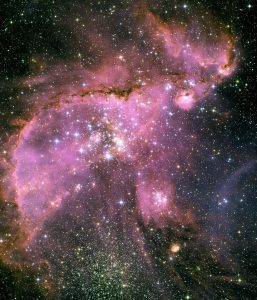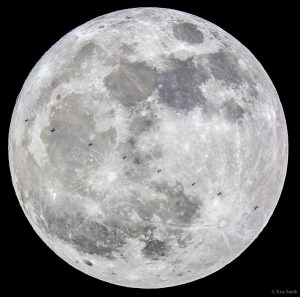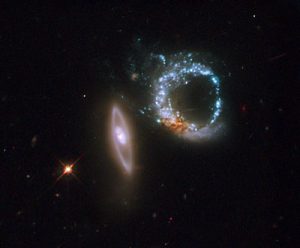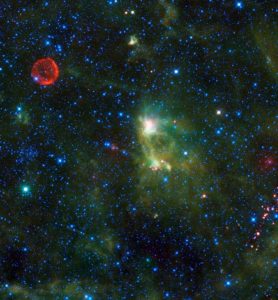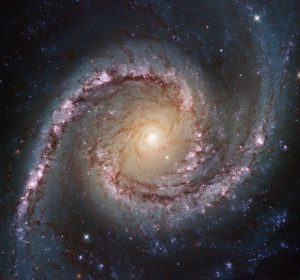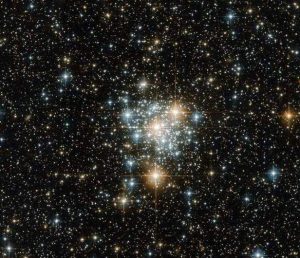Immagini
Giovani stelle creano sculture artistiche
Questa spettacolare immagine ripresa dal telescopio spaziale Hubble rivela i dettagli di una delle regioni di formazione stellare più dinamiche e complesse nello spazio, a 210.000 anni luce di distanza nella Piccola Nube di Magellano, una galassia nelle vicinanze della Via Lattea. Continua a leggere
Supermoon and Space Station
Astronomy Picture of the Day
2016 November 14
Le macchie visibili di fronte alla Luna in questa bella immagine sono sagome della Stazione Spaziale Internazionale (International Space Station, ISS). Utilizzando un’attenta pianificazione e una grande precisione nei tempi, un meticoloso fotografo ha ripreso dieci immagini del passaggio della ISS di fronte alla Luna piena del mese scorso. Continua a leggere
Ritratto di Famiglia Stellare
Questa magnifica immagine del Very Large Telescope riprende la vasta nursery stellare NGC 3603, in cui nascono continuamente stelle. Immerso in questa scenica nebulosa si trova uno degli ammassi di giovani stelle massicce più luminosi e compatti della Via Lattea, un analogo “locale” di regioni di formazione stellare molto attive in altre galassie. Continua a leggere
Una stella neonata arde nel firmamento
I filamenti perlacei che circondano la stella IRAS 10082-5647 in questa mirabile immagine del telescopio Hubble attirano sicuramente lo sguardo. La nube fumosa è una nebulosa a riflessione, formata da gas e polveri, che brilla delicatamente per la luce riflessa di stelle nelle vicinanze, in questo caso una stella Ae/Be di Herbig estremamente giovane. Continua a leggere
Un bel dieci per Hubble
Questa incredibile coppia di galassie interagenti viene chiamata Arp 147, e questa volta, come molte altre, Hubble si merita un bel 10 in termini di bellezza. Continua a leggere
Storica bellezza
Il resto di supernova di Tycho (SN 1572), il cerchio rosso visibile nella parte superiore sinistra dell’immagine, è il residuo di un’esplosione stellare così chiamata dal nome dell’astronomo Tycho Brahe, anche se all’epoca non è stata l’unica persona ad osservare e registrare la supernova. Continua a leggere
Una coppia magnifica
Davvero spettacolare l’abbinamento tra la stella Hen 2-427, conosciuta più comunemente come WR 124, e la nebulosa M1-67 che la circonda. Entrambi gli oggetti, ripresi dal telescopio Hubble, si trovano nella costellazione del Sagittario, a circa 15.000 anni luce di distanza. Continua a leggere
Come un Girasole
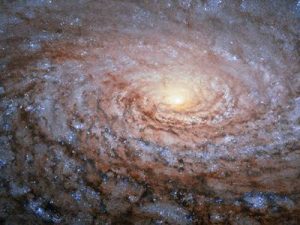 La disposizione dei bracci di spirale della galassia Messier 63, visibile in questa immagine ripresa dal telescopio Hubble, richiama alla mente la struttura nel centro di un girasole per il gran numero di segmenti di spirale che circondano il nucleo, pervasi da nubi di polvere interstellare Continua a leggere
La disposizione dei bracci di spirale della galassia Messier 63, visibile in questa immagine ripresa dal telescopio Hubble, richiama alla mente la struttura nel centro di un girasole per il gran numero di segmenti di spirale che circondano il nucleo, pervasi da nubi di polvere interstellare Continua a leggere
Vortici Maestosi da Hubble
Questa immagine mozzafiato ripresa dal telescopio Hubble mostra NGC 1566, una splendida galassia situata a circa 40 milioni di anni luce di distanza nella costellazione del Dorado. NGC 1566 è una galassia a spirale intermedia: anche se non ha una regione di stelle ben definita a forma di barra al suo centro, come le spirali barrate, non è nemmeno una spirale non barrata. Continua a leggere
Uno Scrigno di Gioielli nel Tucano
Anche se potrebbe essere già famosa per ospitare oggetti spettacolari come la galassia nana del Tucano e 47 Tucanae, il secondo ammasso globulare più brillante nel cielo notturno, la costellazione australe del Tucano possiede una varietà di bellezze cosmiche poco conosciute. Uno di questi gioielli è NGC 299, un ammasso stellare aperto localizzato all’interno della Piccola Nube di Magellano a circa 200.000 anni luce di distanza. Continua a leggere
